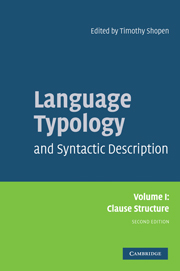Book contents
- Frontmatter
- Contents
- List of figures
- List of tables
- List of contributors
- Acknowledgements
- List of abbreviations and symbols
- 1 Parts-of-speech systems
- 2 Word order
- 3 The major functions of the noun phrase
- 4 Clause types
- 5 Speech act distinctions in grammar
- 6 Passive in the world's languages
- 7 A typology of information packaging in the clause
- Bibliography
- Subject index
2 - Word order
Published online by Cambridge University Press: 16 January 2010
- Frontmatter
- Contents
- List of figures
- List of tables
- List of contributors
- Acknowledgements
- List of abbreviations and symbols
- 1 Parts-of-speech systems
- 2 Word order
- 3 The major functions of the noun phrase
- 4 Clause types
- 5 Speech act distinctions in grammar
- 6 Passive in the world's languages
- 7 A typology of information packaging in the clause
- Bibliography
- Subject index
Summary
Introduction
One of the primary ways in which languages differ from one another is in the order of constituents, or, as it is most commonly termed, their word order. When people refer to the word order of a language, they often are referring specifically to the order of subject, object, and verb with respect to each other, but word order refers more generally to the order of any set of elements, either at the clause level or within phrases, such as the order of elements within a noun phrase. When examining the word order of a language, there are two kinds of questions one can ask. The first question is simply that of what the order of elements is in the language. The second question is that of how the word order in the language conforms to cross-linguistic universals and tendencies. Our discussion in this chapter will interweave these two kinds of questions.
Some basic word order correlations
Verb-final languages
We will begin by examining a few of the word order characteristics of three verb-final languages, languages in which the verb normally follows the subject and object. Consider first Lezgian, a Nakh-Daghestanian language spoken in the Caucasus mountains, in an area straddling the border between Azerbaijan and Russia (Haspelmath (1993)). The example in (1) illustrates the verb-final order in Lezgian.
Information
- Type
- Chapter
- Information
- Language Typology and Syntactic Description , pp. 61 - 131Publisher: Cambridge University PressPrint publication year: 2007
Accessibility standard: Unknown
Why this information is here
This section outlines the accessibility features of this content - including support for screen readers, full keyboard navigation and high-contrast display options. This may not be relevant for you.Accessibility Information
- 53
- Cited by
